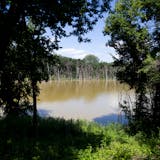Lots of city folk have "cabins" Up North. It might be a log home or a three-bedroom cottage or even a sprawling multi-level, multi-deck vacation getaway.
Every weekend, Susan Borden and Steve Bunge escape to a rustic, back-to-the-basics cabin in the wilderness on the edge of the Boundary Waters Canoe Area.
Their tiny pine retreat draws well water from a hand pump, is lit by lanterns, and the bathroom is an outhouse down a path. And, of course, there's no Wi-Fi.
In fact, their 600-square-foot cabin, built in 2014, is completely off the grid. For the couple, that's one of its most precious qualities.
"Living there makes you realize how little you need," said Bunge. "It's OK if it's 30 below zero. We have a little wood stove, great meals and only go outside when we need to."
The outdoorsy couple met 10 years ago, drawn together by their love of camping, canoeing and cross-country skiing — especially in the Ely area, a favorite destination.
Although Bunge and Borden enthusiastically portage and hike to remote rental cabins or camping spots, they decided to find buildable property, accessible for all ages and abilities, to share with family for future decades.
"We didn't want to have to paddle a canoe to get to it," said Bunge.


